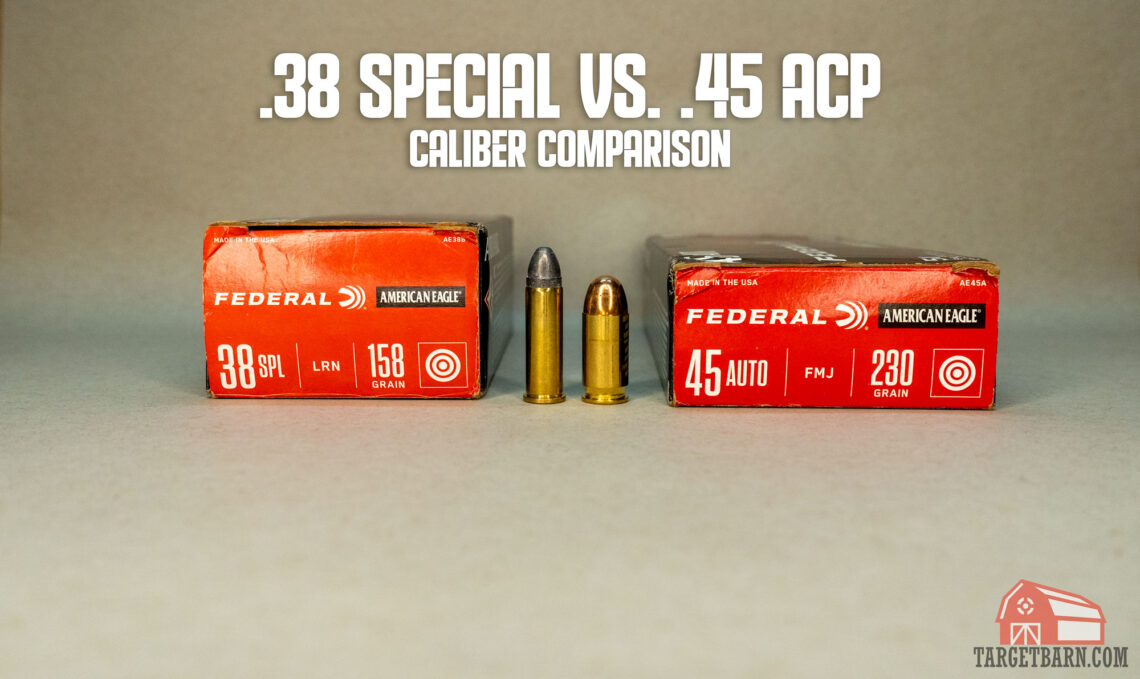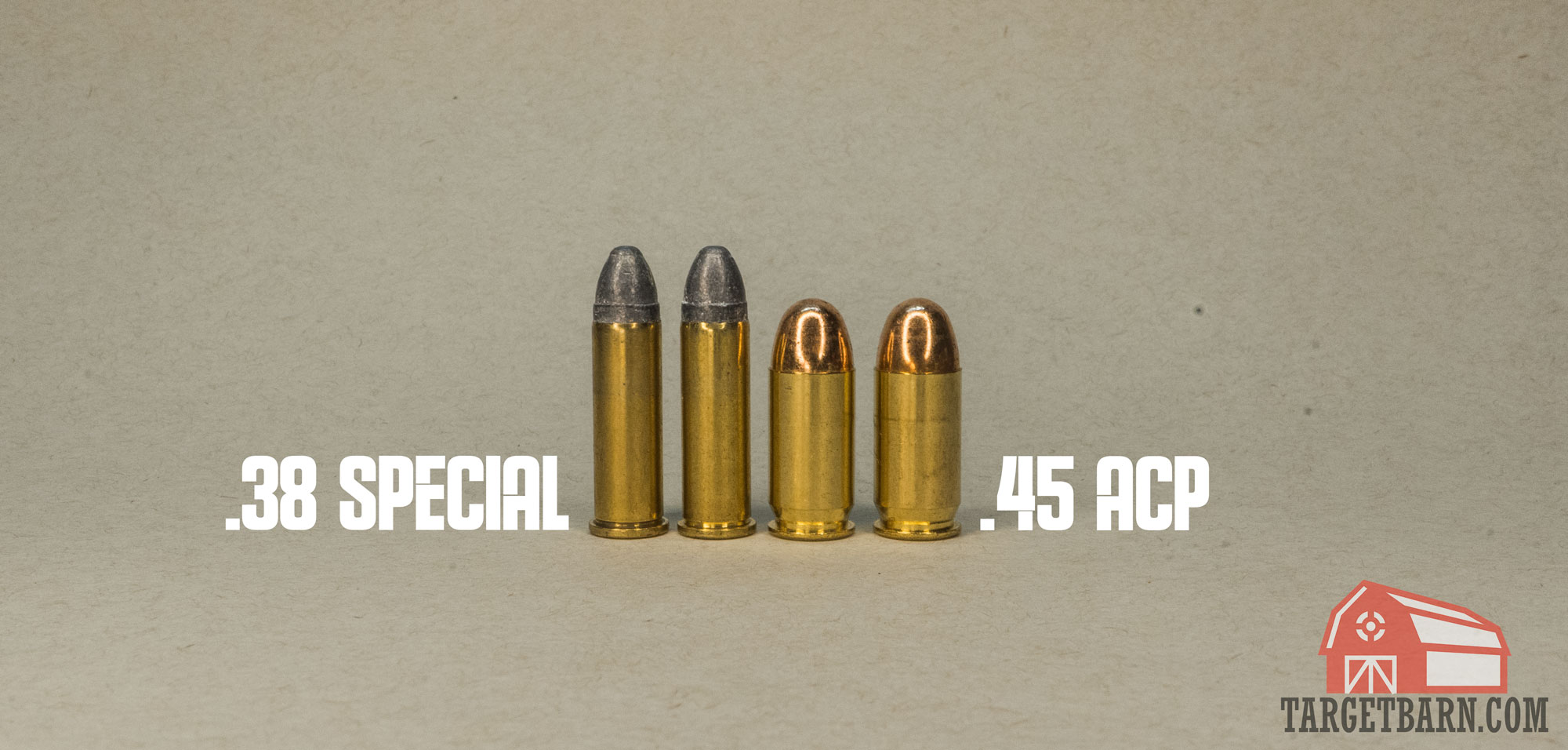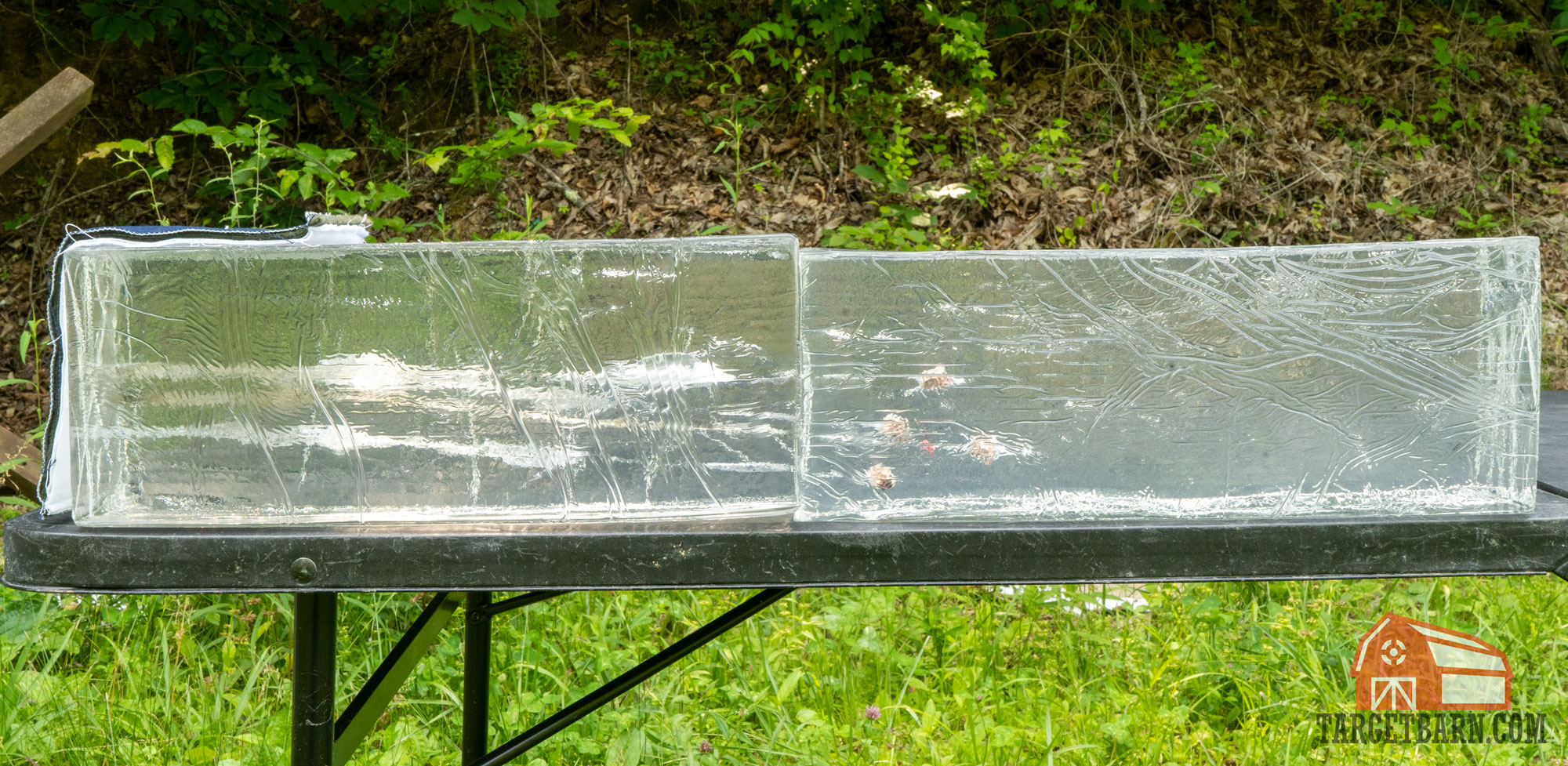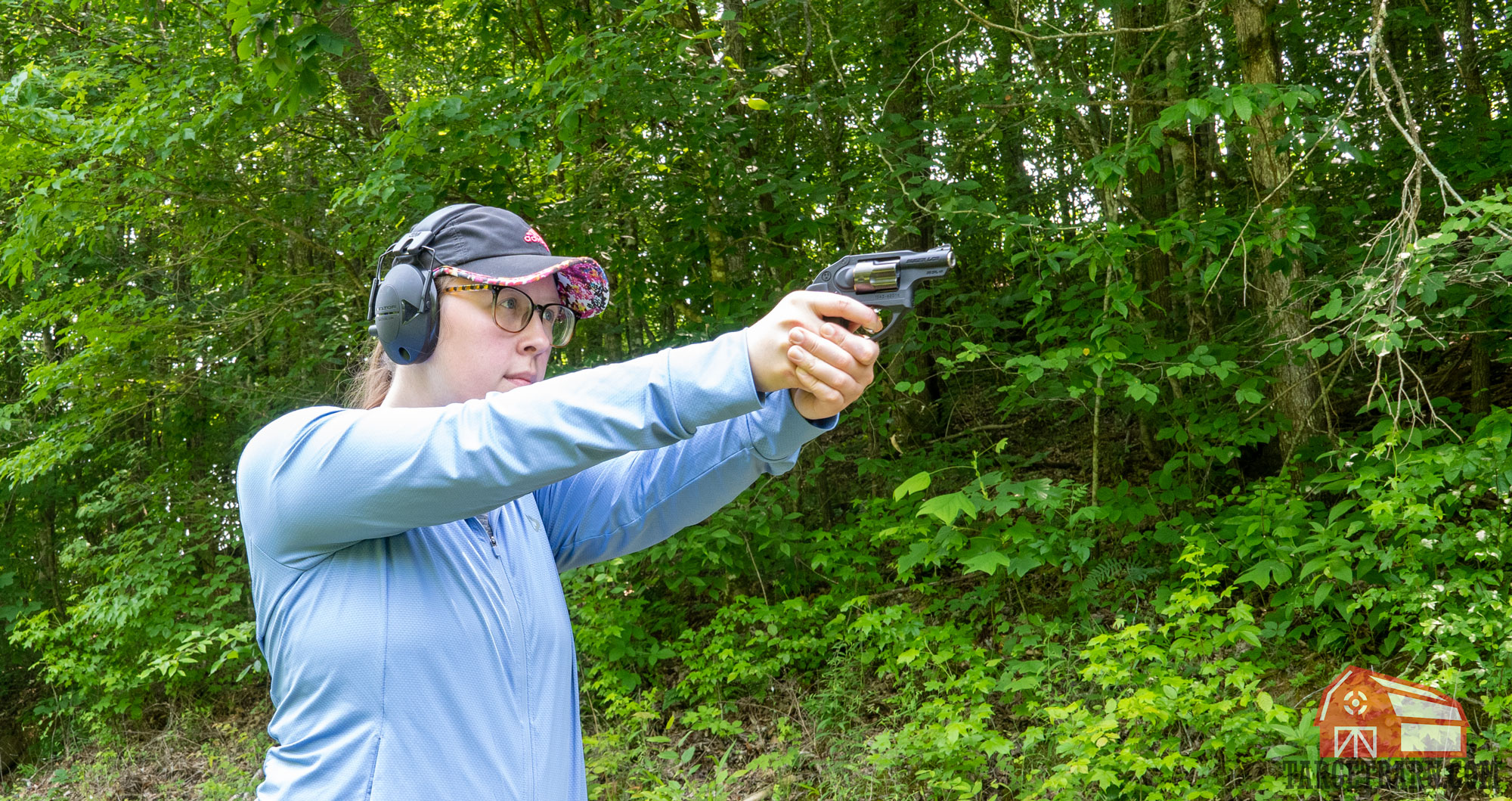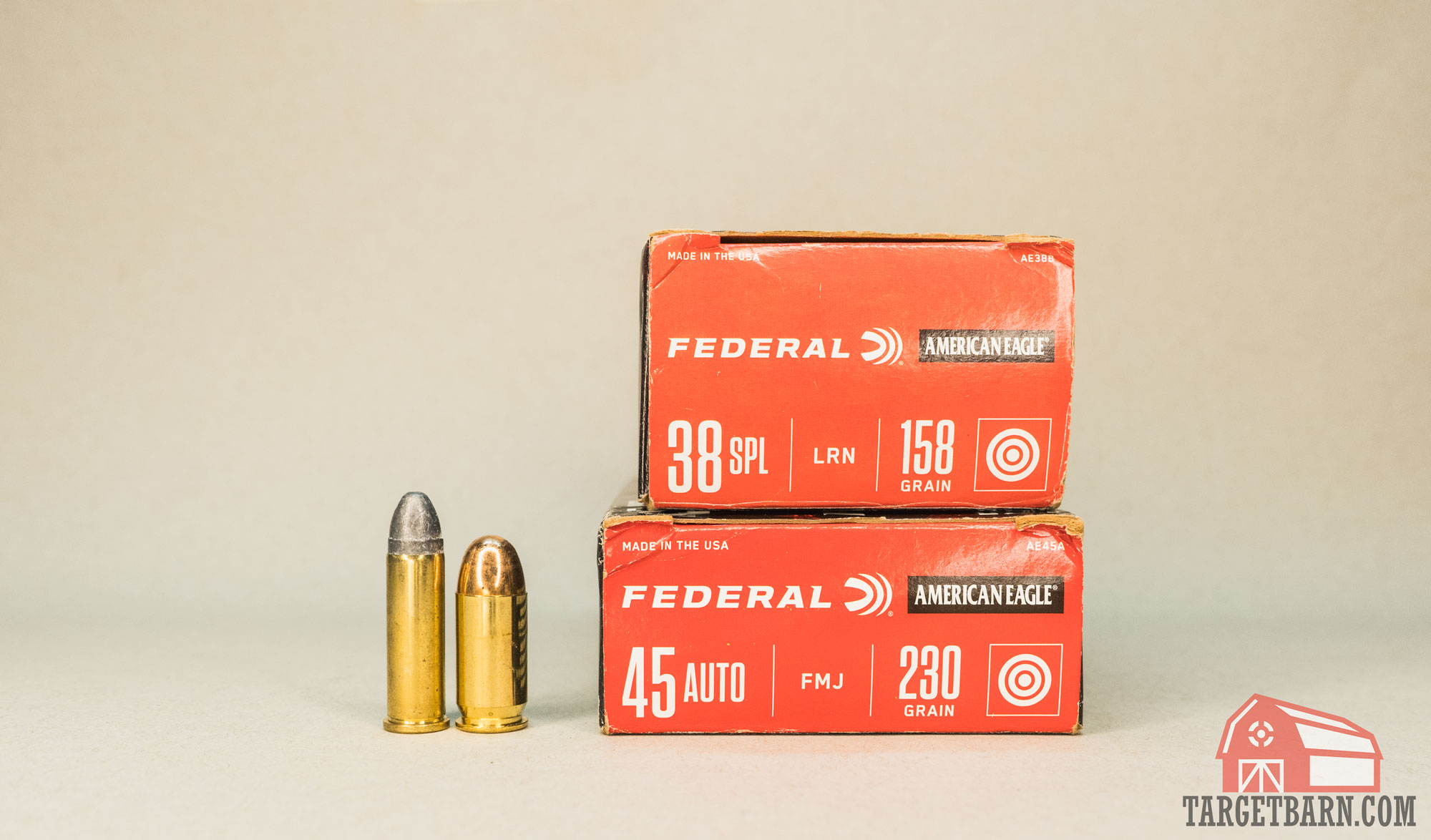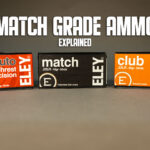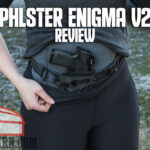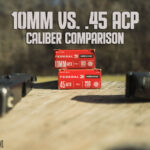Two common self defense rounds a shooter might choose between are the .38 Special vs. .45 ACP. Both rounds originated in the USA and saw use as military and law enforcement service weapons. The popularity of the .38 Special and .45 ACP have waned over time, but they are still two options shooters have when selecting a self defense gun.
Let’s take a deeper look at the differences between these two classic American rounds.
.38 Special vs. .45 ACP: The Basics
- Both the .38 Special and .45 ACP rounds were developed in the USA within six years of each other.
- The .38 Special has a longer overall length than the .45 ACP
- The .38 Special bullet diameter is .357”; the .45 ACP bullet diameter is .452”
- The .38 Special cartridge is slightly taller and skinnier than the .45 ACP cartridge
- Both rounds have similar velocities, however, the .38 Special bullet is lighter than the .45 ACP bullet
- Both cartridges have seen law enforcement and military use and been popular among civilians for concealed carry
.38 Special vs. .45 ACP Specifications
| .38 Special | .45 ACP | |
|---|---|---|
| Designed | 1898 | 1904 |
| Designer | Smith & Wesson | John Browning |
| Place of Origin | United States | United States |
| Parent Cartridge | .38 Long Colt | |
| Case Type | Rimmed, straight | Rimless, straight |
| Bullet Diameter | .357" | .452" |
| Rim Diameter | .44" | .480" |
| Case Length | 1.155" | .898" |
| Overall Length | 1.550" | 1.275" |
| Common Bullet Weights | 100 to 147 grains | 165 to 255 grains |
| Maximum Pressure (SAAMI) | 17,500 psi | 21,000 psi |
The .38 Special is a revolver round. In fact, it’s arguably the most popular revolver caliber on the planet. Its bullet diameter is .357” and common bullet weights range from 100 to 147 grains. Standard pressure .38 Special rounds see slow muzzle velocities, typically in the 700 to 900 fps range when fired out of short barrel revolvers. Shooters can opt for .38 Special +P, or overpressure rounds, that run a little hotter, giving slightly higher velocities.
The .45 ACP cartridge is most closely associated with the legendary 1911 pistol. However, there are plenty of other semi-auto pistols chambered in the caliber. You can even shoot .45 ACP in some revolvers with the use of a moon clip. The .45 ACP bullet is .452” in diameter and most often uses a bullet between 165 to 255 grains. Typical .45 ACP muzzle velocities are in the 750 to 950 fps range. .45ACP ammo is easy to find, but not as affordable as other semi-auto calibers like 9mm rounds.
.38 Special vs. .45 ACP Ballistics
One way to examine how defensive .38 Special vs. .45 ACP rounds perform is through ballistic testing. In order to see how each round might perform in real-world shooting, we shoot them through Clear Ballistic’s 10% synthetic ballistic gel with a 4-layer fabric covering. As per the FBI’s ballistic testing, rounds are shot from a 10-foot distance.
First, we can look at penetration in the ballistic gel. The FBI’s standards call for a penetration depth between 12 and 18 inches as it correlates with rounds that adequately penetrate soft tissue. We want a round that reaches vital organs, but we don’t want a round that passes clear through and potentially harms a bystander.
Next, we can look at bullet expansion by digging the fired bullets out of the gel. There is no standard expansion, but experts generally look for an expanded diameter of 150% of the original diameter of the bullet. So, for .38 Special that is .536” and for .45 ACP is .678”. A bullet that adequately expands will create a larger wound channel. It also helps prevent over-penetration.
Keep in mind, these tests are used to give an idea of how these rounds might perform. They should not be the only factor when choosing a round as there are other factors that impact a round’s feasibility for carry.
.38 Special Ballistics
| Average Penetration | Average Expansion | |
|---|---|---|
| Remington HTP +P 125gr. SJHP | 12" | .489" |
| Winchester Super-X 148gr. Super Match Wadcutter | 15.625" | .369" |
The issue with shooting .38 Special out of short-barreled revolvers is that the bullet’s muzzle velocity stays under 1,000 fps which isn’t enough to expand when it hits ballistic gel. Instead, it typically will over-penetrate with little to no expansion. Even with overpressure rounds we see this problem. The Remington HTP +P125gr. SJHP we fired through the ballistic gel reached the 12″ penetration depth, but didn’t have the expansion we want to see.
For this reason, it’s typically advised to carry wadcutters, like the Winchester Super-X 148gr. Wadcutter, in snub-nosed revolvers for self defense. Instead of expanding, the sharp shoulders of the wadcutter will create a large wound channel. Wadcutters also have much less recoil than other .38 defensive rounds which are easier to shoot accurately than the hot JHP loads.
.45 ACP Ballistics
| Average Penetration | Average Expansion | |
|---|---|---|
| Hornady Critical Duty 220gr. +P | 19.875" | 0.549" |
| Black Hills 135gr. HoneyBadger | 18.375" | 0.452" |
Most defensive .45 ACP rounds use a bullet between 185gr. to 230gr. traveling out of the muzzle at around 750-950fps. Generally, the .45 ACP round has no problem penetrating the minimum of 12-inches we look for. However, some .45ACP rounds are prone to clogging up from heavy clothing which results in over-penetration. In ballistic tests, this can mean over-penetrating through 32-inches of ballistic gel because there is no expansion to slow the bullet down. In the real world, this could mean that a round travels through our target and hits an innocent bystander.
The two rounds we tested both penetrated deeper than we would like without expanding adequately. The good news is that rounds that do expand generally meet the 150% expansion exceptionally. For example, the Federal HST 230gr. JHP consistently penetrates between 12″-18″ and consistently expands to 1.5 times its original diameter.
.38 Special vs. .45 ACP for Self Defense
When choosing between the .38 Special vs. .45 ACP for self defense, there are a few factors to look at. Ballistically, both rounds are adequate for self defense when loaded with the right ammo. So that leaves other factors to look at.
With the .38 Special, you are limited to carrying a revolver. Most carry-sized revolvers hold five rounds in the cylinder. This means if you want to carry more rounds, you’ll have to carry a speedloader.
Lightweight snubbies can have very snappy recoil, especially when loaded with hot .38 rounds. Heavy recoil can have a negative effect on accuracy, especially for less experienced shooters. For that reason, you’ll want to choose snubbie ammo like wadcutters that have manageable recoil and solid ballistic performance.
Many shooters choose .45 ACP for self defense because of its ballistic performance. While there’s no doubt about the .45 ACP’s stopping power, there are some downsides to carrying one. Many shooters choose to carry full-sized .45s like the classic 1911. While some can conceal a full-size frame just fine, others will have a tough time. Compact and sub-compact .45 ACP pistols can have hard to manage recoil. They also don’t have a large ammo capacity when compared to compact 9mm pistols. For example, the Glock 30 has a standard magazine capacity of 10 rounds.
.38 Special vs. .45 ACP History
Next, let’s briefly take a look at the history of each round.
History of the .38 Special
Due to the .38 Long Colt’s poor performance in the Philippines during the Spanish-American War, the US government sought out Smith & Wesson’s help in designing a new revolver cartridge. Smith & Wesson’s answer was the .38 Special which the company introduced in 1898. While the new round’s bullet was the same diameter as the .38 Long Colt, it was heavier and used a hotter black powder charge. Due to its popularity, Smith & Wesson soon offered the round in smokeless powder loadings.
The .38 Special was the chosen service revolver caliber among American law enforcement from the 1920s to 1980s. It also saw use in World War I, World War II, the Korean War, and Vietnam War.
History of the .45 ACP
After the poor performance of the .38-caliber Colt double-action Model 1892 revolver in the Philippine-American War, the US government sought out a new service caliber and handgun. The Army performed ballistic testing in what is known as the Thompson-LaGarde Tests which showed that a minimum of a .45-caliber bullet was needed to adequately stop enemies.
In 1904, legendary gun designer John Browning and firearms manufacturer Colt had been working on a .41-caliber semi-auto cartridge in 1904. At the request of the US Cavalry, Browning modified the design to a .45-caliber. The results were the Model 1905 and the .45 ACP cartridge which fired a 200 grain bullet with a 900 feet per second muzzle velocity.
The design made it to the second round of evaluations in 1910, but needed some changes. In 1911, the United States Ordnance Department eventually adopted the .45 ACP and Model 1911 Colt-Browning automatic pistol. The final iteration of the cartridge used a 230 grain bullet that had an 850 feet per second muzzle velocity.
.38 Special vs. .45 ACP Cost
Next, you’re probably curious about cost differences between the .38 Special vs. .45 ACP. While prices fluctuate regularly, .38 Special and .45 ACP are generally priced similarly. At the time of writing this article, standard range rounds for both calibers range between 44¢ to 70¢ per round. Of course, certain brands and bullet types will cost more than others, but generally the price differences between comparable rounds are not huge.
Which Should You Choose?
If your only two carry options are between .38 Special vs. .45 ACP, then you should choose the round that you shoot best. Both rounds are more than adequate for self defense, especially when carrying a quality gun and ammo. Whichever round you choose, be sure you practice with your carry gun and ammo to be sure everything runs as it should.

